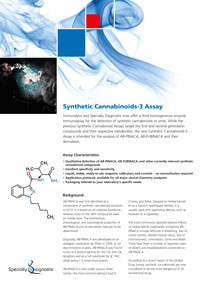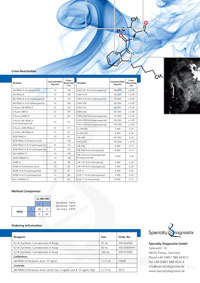Specialty Diagnostix and Immunalysis now introduce a third homogeneous enzyme immunoassay for the detection of synthetic cannabinoids in urine. While Synthetic Cannabinoid Assays 1 and 2 targeted the first and second generation compounds and their respective metabolites, the new Synthetic Cannabinoids-3 Assay is intended for the analysis of AB-PINACA, AB-FUBINACA and their derivatives.
Synthetic Cannabinoids-3 Urine HEIA
Assay Characteristics
- Qualitative detection of AB-PINACA, AB-FUBINACA, and other currently relevant synthetic cannabinoid compounds
- Excellent specificity and sensitivity
- Liquid, stable, ready-to-use reagents, calibrators and controls – no reconstitution required
- Application protocols available for all major clinical chemistry analyzers
- Packaging tailored to your laboratory’s specific needs

Background
AB-PINACA was originally developed by Pfizer as an analgesic medication. In rat discrimination studies, AB-PINACA was found to act as a potent agonist for the CB1 and CB2 receptors and as a full substitute for Δ9-THC, while being 1.5 times more potent. There have been a number of reported cases of deaths and hospitalizations connected to AB-PINACA. In Germany, the compound is listed in Anlage II and thus illegal as of November 2014. In the USA, it is a Schedule I controlled substance.
AB-PINACA was first identified as a component of synthetic cannabinoid products in 2012. It is based on an indazole backbone, whereas most of the JWH compounds have an indolyl base. The biochemical, physiological, and toxicological properties of AB-PINACA and its derivatives have yet to be determined.
AB-PINACA is sold under various street names, the most common being Cloud 9, Crown, and Relax. Sprayed on herbal blends or as a liquid in eyedropper bottles, it is used with vaporizing devices, such as hookahs or e-cigarettes. The most commonly reported adverse effects of herbal blends supposedly containing AB-PINACA include agitation, tachycardia, drowsiness, lethargy, vomiting and confusion. Other reported effects were difficulty in breathing, loss of motor control and/or consciousness, altered mental status, convulsions, seizures, coma and death.





